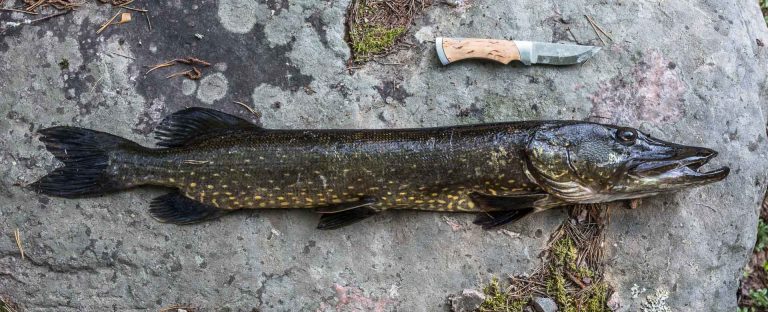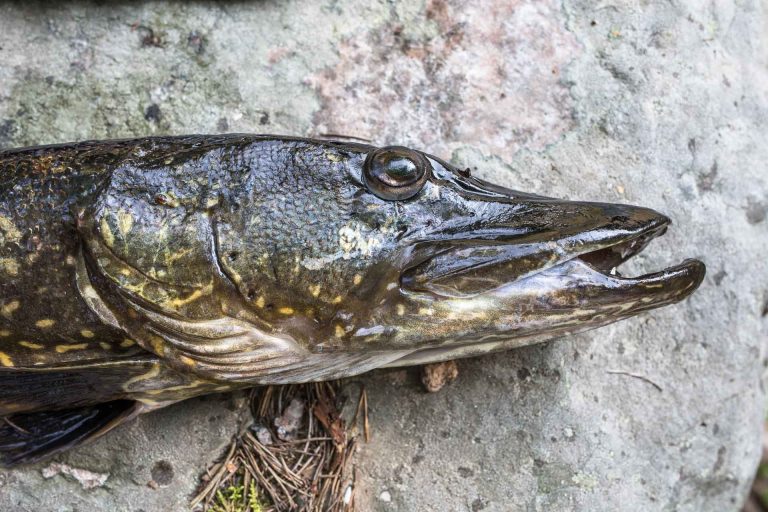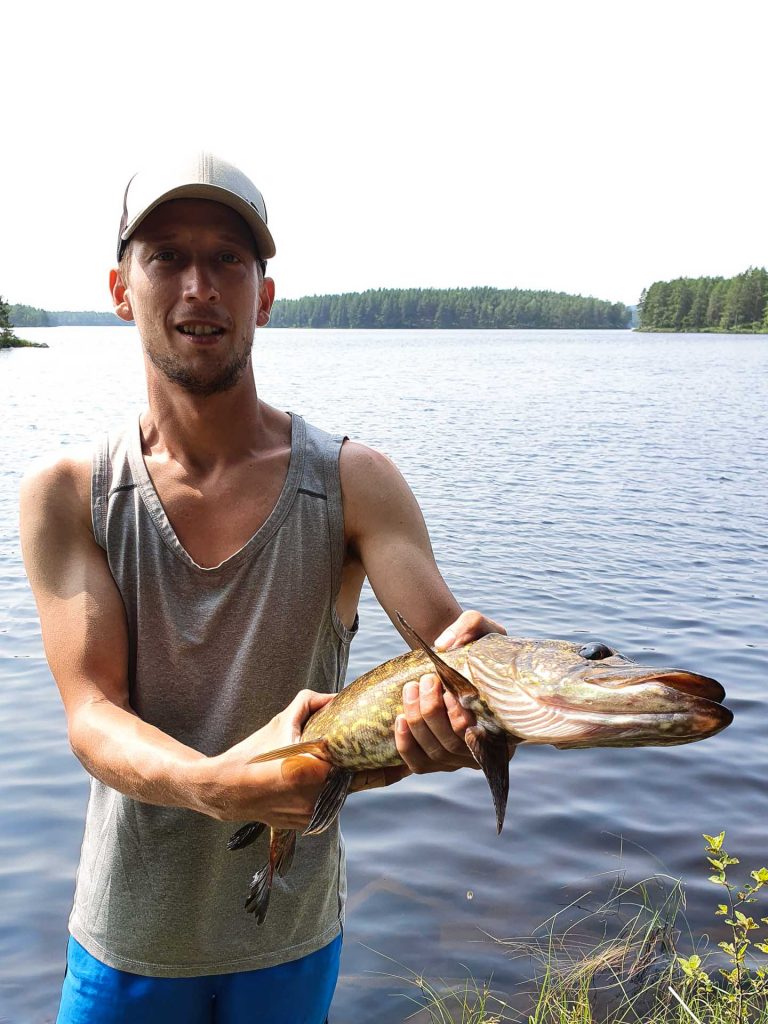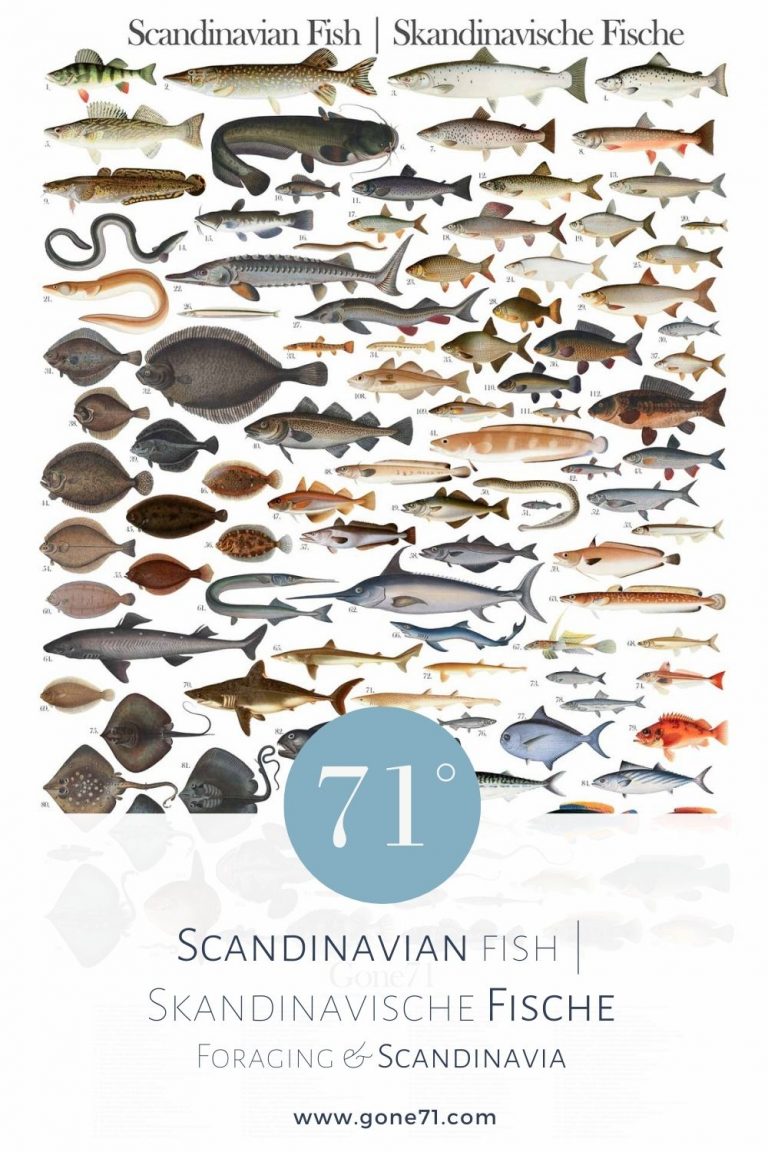Pike (nor.: gjedde; swe.: gädde; fin.: hauki; dt.: Hecht)

The greediness of pike knows no bounds, (Sergei Aksakov, 1847)
Pike is the second most common fresh-water fish species after perch in Scandinavia and inhabits lakes, rivers and coastal areas of the Baltic Sea throughout the North.
“The greediness of pike knows no bounds” wrote the Russian author Sergei Aksakov 1847 in his famous notes on fishing. Swedes refer to it as “crocodile” and it is not uncommon that they tackle larger fish than themselves and suffer coat. There are even those campfire stories of pikes swallowing whole ducks if they reach their record size of one and a half meters.
It is a torpedo shaped and well-camouflaged predator from head to tail equipped with hundreds of razor sharp, backward-pointing teeth. The best fishing grounds for pikes in whole Europe can be found in the lake land of Finland but also in the Southern parts of Sweden. Especially in Finland this fish is quite controversial. Fins either love pike or they hate it. Many despise it due to the taste of the white, flaky meat. They see pike as inferior especially in comparison to their salmonid relatives. Nevertheless many locals, especially in the south consider this fish as delicious and because they are so willingly taking lures they are a great game. Specimens up to 20 kg are caught every year but usually a one-meter pike is considered a respectable trophy.

For beginners and Pros
Pikes are a good target if you just start your spin fishing career or want to have a quick nourishing dinner at the campfire. They can be found in pretty much all waters from lakes over rivers and in the brackish waters of the Bothnian- and Baltic Sea. Pike can be caught the whole year round with autumn (October till ice) and spring (April, May) when they feed heavily after spawning to be the best times of the year. When the water gets warmer, bigger fish will move on into deeper waters.
Whatever you do keep your fingers away from their teeth at all time if you want to keep them in one piece!
Fishing and Fishing Methods
Pike are fished in almost every possible way. However, the methods for fishing on these predators depend on the waters you fish in. The most common way to catch pike is spin fishing but trolling and vertical jigging is also common. The latter one is the way to go for big pike in open waters and produces usually the biggest catches. An other common way to tackle this fish is with live (or dead) bait, usually whitefish mainly used when ice fishing in winter.
Any season is suitable for lure pike fishing. In winter, pike is persued by ice fishing. In spring, when the ice is gone there are many differences in lure fishing between lakes and the Baltic sea. On lakes, the spring season can be quite short if the water warms up quickly and the pike spawning season starts. At sea, the waters heat up more slowly and unevenly, allowing pike to be fished in shallow reed bays for much longer than their lake cousins. After spawning pikes start hunting again very actively.
Midsummer is perhaps the most challenging time to fish, especially the larger pike. Then the pike can also eat poorly due to too hot water. At this time oft he year usually cloudy and windy conditions are the best.
In the autumn, when water temperatures drop again lure fishing gets easier again. Pike are most commonly found at the aquatic plant borders or on the edges of benches and ditches a short distance from the shore. As autumn progresses and vegetation decreases they move to the edges of the benches and even deeper in late fall.

Spinning
- Wobbler small (0-10 cm)
- Wobbler between (11-20 cm)
- Spinners between (6-12 grams)
- Jig / Soft Bait
- Jerkbait / Swimbait
- Spoons
Trolling
- Wobbler small (0-10 cm)
- Wobbler between (11-20 cm)
- Wobbler large (21+ cm)
Ice Fishing
- Live fish
- Dead fish
Fishing Records
- Finland: 18,8 kg
- Sweden: 21,07 kg
- Norway: N/A
How does it taste
Their white firm flesh features some Y-shaped bones, which are easy to remove if you bake the fish as a whole (e.g. at a campfire). We consider pike as great tasting fish and if you have to feed a lot of people it is a great fish to host a feast. Its meat is very juicy when well cooked/baked and there are several possibilities to enjoy this fish.
Other Pike Facts
Appeareance
The sides and gill covers of the pike are green and have various yellow patterns, the belly is white and the back is almost black. Dark-colored fins vary in color, they can be reddish or yellowish brown. The eyes are dark with a yellowish ring. The degree of darkness of the color varies somewhat: in dark water and ground-based waters it is darker and in clear water and sand-gravel-based waters much lighter.
The body of the pike is long, slender and round in the cross-section, the fins are concentrated at the back of the body. The head is large and the mouth opening huge, the jaws are crocodile-lengthened and the teeth are sharp. There are a total of about 700+ teeth and, in addition to the jaws, they are found in the bones of the oral cavity, palate and tongue. The pike’s hearing and visual senses are effective, but the sense of smell is quite weak.
Size and age
Pike grow throughout their lives, up to four years of age at about 10 centimeters a year, after which growth slows. In its first summer, it can already be 15 centimeters long and under favorable conditions it can grow up to 20 centimeters a year. In older age, however, growth is slowing, and 15-year-old pike are only growing a few inches a year. In addition to age, growth is also slowed by poor nutritional conditions or too hot water, as well as by going further north, but the climate impact of the north is reduced in older individuals.
Typically, the pike is 40 to 60 cm long and weighs 0.5 to 2 kg. However, it can grow up to 35 kg in weight and 160 cm in length and live up to 30 years of age. Females live on average longer and grow faster than males.
Telling the largest pike caught reliably is challenging, as numerous fish stories are told about it as a popular sport fishing destination. The world record is 30.5 kg 146 cm. However, individuals over 20 kg are reported to have been caught in Scandinavia and over 35 kg worldwide.
Behavior
In general, the pike is a territory fish. In large lakes, especially those with vendace, some of the pike move almost completely after large flocks of vendace.
Reproduction
Usually spawning begins with water temperatures at 4 ° C. Spawning grounds are floodplains, small rivers and other shallow and sheltered places. In larger lakes, spawning often begins already during the winter time when there is still ice on the surface and before the lake has even properly melted. The water in the lakes warms up faster in the spring in the spawning grounds, so that at sea the spawning can start a little later and lasts longer due to the greater variation in water temperature.
Food
The pike relies on the sense of sight and, in turbid waters, on ist sensors on the rib line. The main food source for the pike are ussually smaller fish. However it eats everything from smaller frogs to small birds and mammals. Pikes are very opportunistic and practically feed on the fish that is available. They are also well known for their cannibalistic behavior.
Distribution
Pike are found in inland waters throughout the northern hemisphere. In North America, it occurs from Alaska to the east coast on the southern border of northern Arizona, northern New Mexico, northern Texas, Missouri and Maryland. In Europe, the southern boundary of the range is France and the northern parts of Italy and Greece. It is absent from central Norway, the Kola Peninsula and the islands of the Arctic Ocean, but it occurs throughout the Baltic Sea coast.

